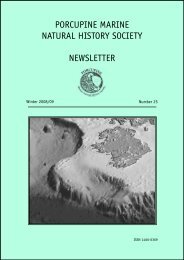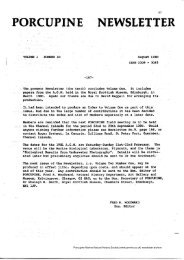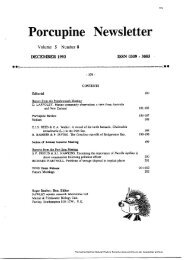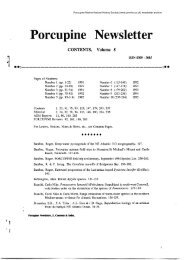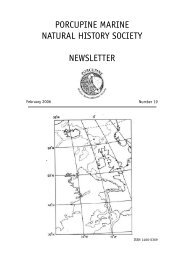PORCUPINE MARINE NATURAL HISTORY SOCIETY NEWSLETTER
PORCUPINE MARINE NATURAL HISTORY SOCIETY NEWSLETTER
PORCUPINE MARINE NATURAL HISTORY SOCIETY NEWSLETTER
Create successful ePaper yourself
Turn your PDF publications into a flip-book with our unique Google optimized e-Paper software.
18<br />
quality (Ketmaier et al, 2003). Sand-hoppers<br />
have a particularly low ability to disperse<br />
between beaches that are discontinuous. Some<br />
offshore sub-tidal sandbanks are also relatively<br />
isolated, which could allow some populations<br />
of H. arenarius to slightly diverge from the<br />
more familiar beach inhabiting ones. This could<br />
include growing to slightly larger sizes on some<br />
offshore tide swept sandbanks.<br />
Only two other species in the genus<br />
Haustorius are known on the eastern side<br />
of the north Atlantic, but both live much<br />
further south on Mediterranean and North<br />
African beaches, (Bellan-Santini, 2005). On<br />
the American side of the Atlantic, in addition<br />
to H. canadensis which has many similarities<br />
with H. arenarius, there are a number of closely<br />
related genera, often with several species<br />
(Barnard, 1969; Bousfield, 1965; 1970; 1973).<br />
Some of these American species live offshore<br />
on the continental shelf down to about 100<br />
m, while others occupy separate ecological<br />
niches on beaches and in estuaries (Croker,<br />
1967). The difference between the diversity of<br />
taxa in the Haustoriinae at similar temperate<br />
latitudes on opposite sides of the Atlantic<br />
seems noteworthy, as is the spread of habitats<br />
occupied by the single Haustorius species<br />
found in Britain and Ireland. Perhaps, sharing<br />
ancestry with H. canadensis, the British species<br />
may be a geologically recent colonist and,<br />
without related competitors, has occupied the<br />
wider habitat range.<br />
Figure 1. Location of Bais Bank off north<br />
Pembrokeshire, where a significant population of<br />
Haustorius arenarius was found<br />
PMNHS Newsletter No.24 Summer 2008<br />
REFERENCES<br />
Barnard, J.L. 1969. The Families and<br />
Genera of Marine Gammaridean Amphipoda.<br />
United States National Museum, Bulletin, 271,<br />
535 pp.<br />
Bellan-Santini, D. 2005. European<br />
species of Haustorius; (Crustacea:Amphipoda:<br />
Haustoriidae), with description of a new<br />
Mediterranean species. Journal of Natural<br />
History, 29, 1101-1110.<br />
Bousfield, E.L. 1965. Haustoridae of New<br />
England (Crustacea: Amphipoda). Proceedings<br />
of the United States National Museum, 117,<br />
159-239.<br />
Bousfield, E.L. 1970. Adaptive radiation<br />
in sand burrowing Amphipod Crustaceans.<br />
Chesapeake Science, 11, 143-154.<br />
Bousfield, E.L. 1973. Shallow-Water<br />
Gammaridean Amphipoda of New England.<br />
Cornell University Press.<br />
Carter, R.W.G. 1988. Coastal Environments.<br />
An Introduction to the Physical, Ecological and<br />
Cultural Systems of Coastlines. Academic Press,<br />
London. 617 pp.<br />
Chevreaux, E. and Fage, L. 1925.<br />
Amphipodes. Fauna de France 9. Lechevalier,<br />
Paris.<br />
Croker, R.A. 1967. Niche diversity in five<br />
sympatric species of intertidal amphipods<br />
(Crustacea: Haustoriidae). Ecological<br />
Monographs, 37, 173-200.<br />
Dahl, E. 1952. Some aspects of the ecology<br />
and zonation of the fauna of sandy beaches.<br />
Oikos, 4, 1-27.<br />
Darbyshire, T., Mackie, A.S.Y., May, S.J.<br />
and Rostron, D. 2002. A Macrofaunal Survey<br />
of Welsh Sandbanks. National Museum of Wales<br />
& Countryside Council for Wales. CCW Contract<br />
Report No. 539, 113 pp.<br />
Dennell, R. 1933. The habits and feeding<br />
mechanisms of the amphipod Haustorius<br />
arenarius. J.Linn.Soc. (Zool.), 38, 363.<br />
Dyer, K.R. and Huntley, D.A. 1999. The<br />
origin, classification and modelling of sand<br />
banks and ridges. Continental Shelf Research<br />
19: 1285-1330.



